Traditionalist Issues
 |
 |
 |
 |
 |
 |
 |
Dialogue Mass - CIII
Minor Orders: a Major Matter
The disrepute into which the Minor Orders have fallen after Vatican II was the direct result of the derision heaped upon them by influential reformers eager to “close the gap” between Clergy and laity. This, in turn, was a consequence of a process of rationalization of the supernatural that began with the early 20th-century modernists and pursued its destructive course via the Liturgical Movement.
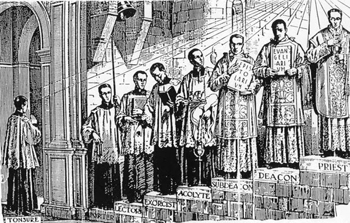 It is inconceivable that such attacks could have succeeded unless the Orders themselves had first been undermined by doubts as to whether the end to which they aimed (the Catholic Priesthood as defined by the Council of Trent) should be upheld as sacrosanct.
It is inconceivable that such attacks could have succeeded unless the Orders themselves had first been undermined by doubts as to whether the end to which they aimed (the Catholic Priesthood as defined by the Council of Trent) should be upheld as sacrosanct.
And it is precisely on this point that the progressivists – these neo-modernists – diverged from Catholic doctrine: These proponents of the revolutionary “new theology” were no longer convinced that the sacramental priesthood, to which the Minor Orders and Sub-Diaconate were incremental stages, transcended all other states of life in dignity and holiness.
In fact, the very idea of climbing a ladder from the lay state to attain this summit of greatness flies in the face of the modern egalitarian Church. According to Pope Francis, “within the Church, no one can be ‘raised up’ higher than others.” (1) The ladder, being of no further use to the reformers, was consequently kicked away.
The transcendent excellence of the Priesthood
But that does not mean that the Minor Orders were unwanted by those who did appreciate their perennial value. In all the centuries before Vatican II, they were presumed to be invested with a supernatural significance and importance for the priesthood, which is no longer understood.
The Council of Trent explained the necessity of these Orders as a fitting preparation for and anticipation of the sacramental Priesthood:
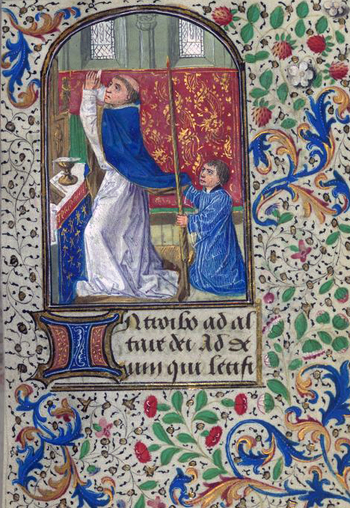 “The ministry of so sublime a Priesthood being a thing divine, it is but befitting its worthier and more reverent exercise that in the Church’s well-ordered disposition there should be several different orders of ministers destined to assist the Priesthood by virtue of their office ‒ orders arranged in such a way that those who have already received clerical tonsure should be raised, step by step from the lower to the higher order.” (2)
“The ministry of so sublime a Priesthood being a thing divine, it is but befitting its worthier and more reverent exercise that in the Church’s well-ordered disposition there should be several different orders of ministers destined to assist the Priesthood by virtue of their office ‒ orders arranged in such a way that those who have already received clerical tonsure should be raised, step by step from the lower to the higher order.” (2)
The salient point in this description of the priesthood is the word “sublime.” Here we may be permitted a short diversion to explain why it was chosen and how it stood in relation to the Minor Orders and Sub-Diaconate.
It is an established fact that, from the earliest centuries, many of the Fathers and Doctors of the Church used this same word when talking of the Priesthood. This can be easily verified by reading St. Alphonsus Liguori’s work on the subject (now among the “forgotten books”). (3) He himself assures us that, of all the states in life, the Priesthood is “the most noble, the most exalted and sublime.” (4)
In that one single word, we find encased the fundamental reason why the Church insisted on keeping the Minor Orders intact in sequence and number. Throughout the Church’s history, these clerical Orders had been organized on the assumption that they possessed a degree of sanctity that obliged the Clergy to respect the pattern prescribed. For centuries, Bishops of the Roman Rite were willing to be guided by this rule of precedent, for the simple reason that the need for continuing the universal custom was clear to them.
They were convinced that, as the Priesthood is a divine institution for bringing the means of eternal life to the faithful through the Mass and Sacraments, it needed to be protected by a juridical structure of custom and law (of which the Minor Orders and Sub-Diaconate are constitutive parts) to serve as bulwarks against assault.
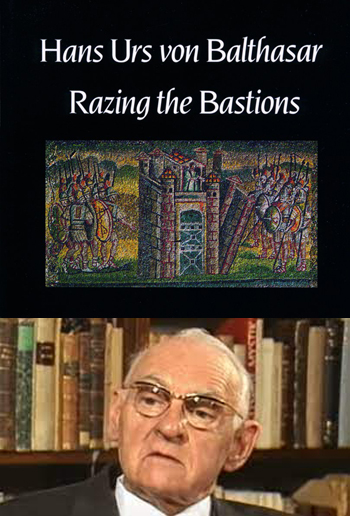 “Razing the bastions” – a common trope of the reformers who no longer wanted to defend the Priesthood – was bound to undermine our faith in the nature of the priesthood as “a thing divine.”
“Razing the bastions” – a common trope of the reformers who no longer wanted to defend the Priesthood – was bound to undermine our faith in the nature of the priesthood as “a thing divine.”
What we can deduce from this is that those who disparage the Minor Orders and Sub-Diaconate necessarily trivialize the Priesthood.
The Council of Trent defined the priesthood first and foremost in terms of its supernatural end – as confecting, offering and administering the Body and Blood of Christ, and absolving sins – for the glory of God and the sanctification of souls. That is what the Popes and Councils taught up to Vatican II. (5)
But Vatican II redefined it in the general context of the active ministry of all the faithful in the Church and the world. As a result of this paradigm shift, the Priesthood is now meant to serve a completely different end, as secular as it is nebulous: working together with all mankind to make a better world. The essential distinction between the sacred and the profane has been lost.
Paul VI: ‘First tonsure is no longer conferred’
Every part of the reformers’ narrative that disparaged the Minor Orders and Sub-Diaconate was used by Pope Paul VI in Ministeria quaedam to sever their connection with the clerical state. In the same document, he abolished the rite of tonsure which, though not an ecclesiastical order, was an ancient ceremony by which candidates for the Priesthood were constituted clerics.
 It was also a rite of passage by which the Church marked off from the laity those whom she called to the service of the altar. Tonsure demonstrably separated the sheep from the goats, so much so that no one could claim (as they do today) that the difference between the Clergy and laity is merely one of splitting hairs.
It was also a rite of passage by which the Church marked off from the laity those whom she called to the service of the altar. Tonsure demonstrably separated the sheep from the goats, so much so that no one could claim (as they do today) that the difference between the Clergy and laity is merely one of splitting hairs.
The rite itself consisted of the ceremonial snipping of a tuft of hair on the candidate’s head. Its symbolism – the abandonment of the world – was reflected in the prayers said by the Bishop and in the new cleric’s statement that “the Lord is the portion of my inheritance” (Ps. 15:5). Henceforth, he would be required to rid himself of all worldly pursuits and manners so as to preserve purity of soul on the road to sacramental ordination.
Pope Paul VI did not accompany his terse announcement with any explanation for his decision to end a custom that had been practised in the Church for over 1,500 years. But the Vatican’s newspaper L'Osservatore Romano stated at the time that the tonsure was abolished because it “had almost completely lost its significance and had become an empty ceremony.”(6)
The person who made this remark, Fr. Paolo Dezza, (7) hastened to assure readers anxious to know if women were excluded from “ministries,” that Ministeria quaedam “does not prevent women from continuing to be commissioned with officially public reading during the liturgy” and that “Bishops can also, in accordance with the norms in force, ask the Holy See to authorize women to distribute Holy Communion as extraordinary ministers.” (8)
The greatest ‘active participation’ for the greatest number
The reformers viewed liturgical tradition in general and the Minor Orders in particular from a utilitarian point of view. They were to be judged not for what they were in their metaphysical essence, but for their usefulness in facilitating the greatest possible number of activities for the laity.
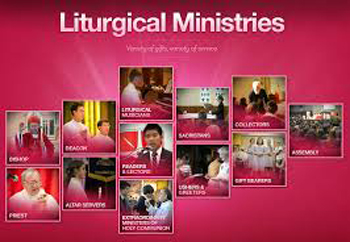
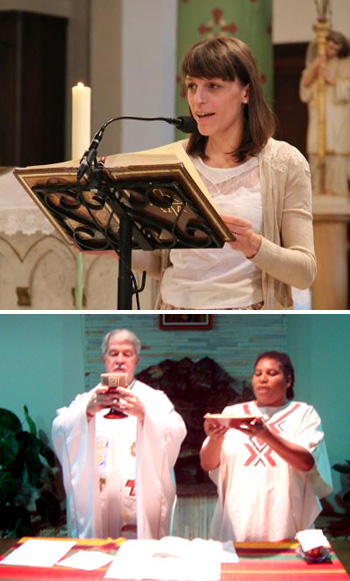 This shows the influence of the false principles of Modernism and Progressivism which were characterized by a rejection of metaphysical reality and a preferential option for agere “doing” over esse “being.”
This shows the influence of the false principles of Modernism and Progressivism which were characterized by a rejection of metaphysical reality and a preferential option for agere “doing” over esse “being.”
For the reformers, being a cleric held no interest or meaning if it was not directed to doing something useful to support and advance the Vatican II reforms. As the Minor Orders were not useful in furthering progressivist aims – egalitarianism, false ecumenism etc., it was decided that they had to be rationalized, i.e., made to conform to modern secular values. The idea that Catholic Tradition has any inherent authority of its own, or any direct claim on our fidelity, is bound to seem absurd from this perspective.
We have seen examples of the strategies used by liturgical reformers to make the Minor Orders seem undesirable, useless and irrelevant, and to rationalize them out of existence. To these once-prestigious Orders must be added that of the Sub-Diaconate, whose meaning has also been evacuated by the same process of rationalization.
Paul VI’s Ministeria quaedam was a repudiation of their clerical nature with a view to altering the hierarchical structure of the Church. With his abolition of the tonsure there were no longer any clerics below the rank of Deacon.
From then on, all Novus Ordo seminarians preparing for the Priesthood would be considered as essentially laymen, placed on a par with all non-ordained members of the faithful. This contributed greatly to the secularization of the Church for, even after they were ordained to the Priesthood, they were placed in the same category as any lay person in active “ministry.” (How this reform affected the spiritual identity of the former Sub-Deacon in Major Orders and his vow of life-long celibacy for service at the altar was not addressed).
To say that these Orders were trashed to accommodate lay “active participation” would not be an exaggeration. They were treated like the proverbial salt that had lost its savor – “good for nothing any more but to be cast out and to be trodden on by [lay] men” (Matt. 5:13) ‒ and, eventually, lay women.
Continued


The traditional scale of Orders – rejected by Vatican II progressivists
And it is precisely on this point that the progressivists – these neo-modernists – diverged from Catholic doctrine: These proponents of the revolutionary “new theology” were no longer convinced that the sacramental priesthood, to which the Minor Orders and Sub-Diaconate were incremental stages, transcended all other states of life in dignity and holiness.
In fact, the very idea of climbing a ladder from the lay state to attain this summit of greatness flies in the face of the modern egalitarian Church. According to Pope Francis, “within the Church, no one can be ‘raised up’ higher than others.” (1) The ladder, being of no further use to the reformers, was consequently kicked away.
The transcendent excellence of the Priesthood
But that does not mean that the Minor Orders were unwanted by those who did appreciate their perennial value. In all the centuries before Vatican II, they were presumed to be invested with a supernatural significance and importance for the priesthood, which is no longer understood.
The Council of Trent explained the necessity of these Orders as a fitting preparation for and anticipation of the sacramental Priesthood:

Priesthood: noble & sublime in its mission
to offer Mass & the Sacraments
The salient point in this description of the priesthood is the word “sublime.” Here we may be permitted a short diversion to explain why it was chosen and how it stood in relation to the Minor Orders and Sub-Diaconate.
It is an established fact that, from the earliest centuries, many of the Fathers and Doctors of the Church used this same word when talking of the Priesthood. This can be easily verified by reading St. Alphonsus Liguori’s work on the subject (now among the “forgotten books”). (3) He himself assures us that, of all the states in life, the Priesthood is “the most noble, the most exalted and sublime.” (4)
In that one single word, we find encased the fundamental reason why the Church insisted on keeping the Minor Orders intact in sequence and number. Throughout the Church’s history, these clerical Orders had been organized on the assumption that they possessed a degree of sanctity that obliged the Clergy to respect the pattern prescribed. For centuries, Bishops of the Roman Rite were willing to be guided by this rule of precedent, for the simple reason that the need for continuing the universal custom was clear to them.
They were convinced that, as the Priesthood is a divine institution for bringing the means of eternal life to the faithful through the Mass and Sacraments, it needed to be protected by a juridical structure of custom and law (of which the Minor Orders and Sub-Diaconate are constitutive parts) to serve as bulwarks against assault.

Von Balthasar, above, like Ratzinger, called for razing the bastions of the Church
What we can deduce from this is that those who disparage the Minor Orders and Sub-Diaconate necessarily trivialize the Priesthood.
The Council of Trent defined the priesthood first and foremost in terms of its supernatural end – as confecting, offering and administering the Body and Blood of Christ, and absolving sins – for the glory of God and the sanctification of souls. That is what the Popes and Councils taught up to Vatican II. (5)
But Vatican II redefined it in the general context of the active ministry of all the faithful in the Church and the world. As a result of this paradigm shift, the Priesthood is now meant to serve a completely different end, as secular as it is nebulous: working together with all mankind to make a better world. The essential distinction between the sacred and the profane has been lost.
Paul VI: ‘First tonsure is no longer conferred’
Every part of the reformers’ narrative that disparaged the Minor Orders and Sub-Diaconate was used by Pope Paul VI in Ministeria quaedam to sever their connection with the clerical state. In the same document, he abolished the rite of tonsure which, though not an ecclesiastical order, was an ancient ceremony by which candidates for the Priesthood were constituted clerics.

Tonsure – a sacred ritual of passage to the priesthood
The rite itself consisted of the ceremonial snipping of a tuft of hair on the candidate’s head. Its symbolism – the abandonment of the world – was reflected in the prayers said by the Bishop and in the new cleric’s statement that “the Lord is the portion of my inheritance” (Ps. 15:5). Henceforth, he would be required to rid himself of all worldly pursuits and manners so as to preserve purity of soul on the road to sacramental ordination.
Pope Paul VI did not accompany his terse announcement with any explanation for his decision to end a custom that had been practised in the Church for over 1,500 years. But the Vatican’s newspaper L'Osservatore Romano stated at the time that the tonsure was abolished because it “had almost completely lost its significance and had become an empty ceremony.”(6)
The person who made this remark, Fr. Paolo Dezza, (7) hastened to assure readers anxious to know if women were excluded from “ministries,” that Ministeria quaedam “does not prevent women from continuing to be commissioned with officially public reading during the liturgy” and that “Bishops can also, in accordance with the norms in force, ask the Holy See to authorize women to distribute Holy Communion as extraordinary ministers.” (8)
The greatest ‘active participation’ for the greatest number
The reformers viewed liturgical tradition in general and the Minor Orders in particular from a utilitarian point of view. They were to be judged not for what they were in their metaphysical essence, but for their usefulness in facilitating the greatest possible number of activities for the laity.

As many lay roles as possible added as ‘ministries,’ also the inclusion of women (below, lector & acolyte)

For the reformers, being a cleric held no interest or meaning if it was not directed to doing something useful to support and advance the Vatican II reforms. As the Minor Orders were not useful in furthering progressivist aims – egalitarianism, false ecumenism etc., it was decided that they had to be rationalized, i.e., made to conform to modern secular values. The idea that Catholic Tradition has any inherent authority of its own, or any direct claim on our fidelity, is bound to seem absurd from this perspective.
We have seen examples of the strategies used by liturgical reformers to make the Minor Orders seem undesirable, useless and irrelevant, and to rationalize them out of existence. To these once-prestigious Orders must be added that of the Sub-Diaconate, whose meaning has also been evacuated by the same process of rationalization.
Paul VI’s Ministeria quaedam was a repudiation of their clerical nature with a view to altering the hierarchical structure of the Church. With his abolition of the tonsure there were no longer any clerics below the rank of Deacon.
From then on, all Novus Ordo seminarians preparing for the Priesthood would be considered as essentially laymen, placed on a par with all non-ordained members of the faithful. This contributed greatly to the secularization of the Church for, even after they were ordained to the Priesthood, they were placed in the same category as any lay person in active “ministry.” (How this reform affected the spiritual identity of the former Sub-Deacon in Major Orders and his vow of life-long celibacy for service at the altar was not addressed).
To say that these Orders were trashed to accommodate lay “active participation” would not be an exaggeration. They were treated like the proverbial salt that had lost its savor – “good for nothing any more but to be cast out and to be trodden on by [lay] men” (Matt. 5:13) ‒ and, eventually, lay women.
Continued
- Pope Francis, Ceremony Commemorating the 50th Anniversary of the Institution of the Synod of Bishops, October 17, 2015.
- Council of Trent, Session XXIII, De sacramento ordinis, chap. 2.
- St. Alphonsus Liguori, Dignity and duties of the priest: or, Selva; a collection of materials for ecclesiastical retreats. Rule of life and spiritual rules, New York: Benziger Brothers, 1889.
- Ibid., p. 41.
- See, for example, Pope Pius XI, Ad Catholici Sacerdotii (On the Catholic Priesthood), December 20, 1935, § 70: “[The seminarian] must look to the Priesthood solely from the noble motive of consecrating himself to the service of God and the salvation of souls.”
- Fr. Paolo Dezza SJ, L'Osservatore Romano, September 14, 1972.
- Fr. Dezza was rector of the Gregorian Pontifical Institute and teacher of Pope John Paul II who attended his lectures when studying in Rome after World War II. Fr. Dezza was also a confessor to Pope Paul VI and Pope John Paul I. He was appointed Cardinal by John Paul II in 1991.
- P. Dezza, ibid., October 6, 1972.

Posted May 31, 2021
______________________
______________________
 Volume I |
 Volume II |
 Volume III |
 Volume IV |
 Volume V |
 Volume VI |
 Volume VII |
 Volume VIII |
 Volume IX |
 Volume X |
 Volume XI |
 Special Edition |


